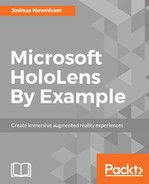In the previous chapter, we explored the opportunities that HoloLens opens up by being able to see everything you see; our exploration began by setting up and walking through the holographic DirectX 11 application template Microsoft has bundled in Visual Studio 2015 Update 3. We then walked through extending this application to detect and identify faces, and display associated metadata about the identified person the user was looking at.
In this chapter, we continue our exploration with how HoloLens can better assist people through a proof of concept example that continuously observes the world, identifying and tracking salient items that you (it) see. If the user happens to forget where an item is, they will be able to ask for assistance and be guided via a breadcrumb trail from the user to the item. For instance, imagine, if you will, a time when you have misplaced your keys and spent vast amounts of time searching for them. Now, imagine a world, in the very near future, where your device can conveniently track your items and lead you to them--possibly adapting the path that best suits your needs, for example, by that is routing you through a wheel chair-friendly path.
Once again, I encourage you to let your imagination wander while you read this chapter, dreaming of how this concept can be extended. One example might involve, identifying what is in the fridge and automatically constructing and presenting a shopping list when the user is in proximity of a grocery store. These are exciting times ahead. With that being said, let's get started!
We will start by introducing the application and all of the major components, then walk through each one until we have a functioning prototype. We begin by mapping out the environment, then tagging the location of the items we detect, and finally, building and rendering the trail from the user to the "lost" item. In this chapter, you will learn the following topics:
- Creating and using SpatialLocatorAttachedFrameOfReference to consider the user's location from the perspective of the device
- Making use of spatial anchors to map the physical world
- Using Microsoft Cognitive Services to recognize objects
